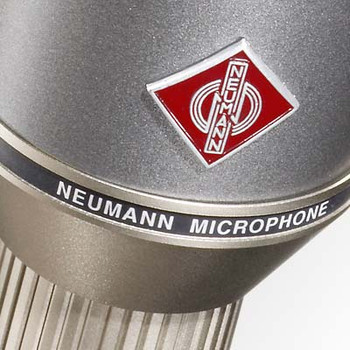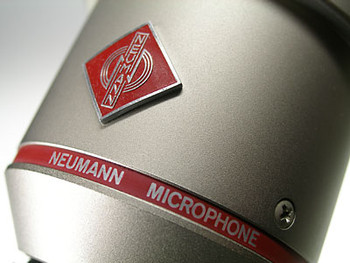Description
In the world of studio microphones, the numbers “47”, “67” and “87” have associations that inspire enthusiasm among professionals in the field. It is of course no coincidence that the name of the new TLM 67* contains the number “67”. In many respects, the TLM 67 is based on the “workhorse” of the 1960s, the legendary U 67. Like the U 67, the TLM 67 incorporates the K 67 capsule. In addition, the special new circuit design closely reproduces the sound characteristics of the classic U 67, without the use of tubes. Similar Neumann circuit technology has already proved very successful in the TLM 49.
The TLM 67 Set Z is extremely versatile. Its three switchable directional characteristics (omnidirectional, cardioid and figure-8), selectable 10 dB pre-attenuation and high-pass filter permit detailed adjustments to be made, depending upon the specific recording situation. It ships in woodbox. The TLM 67 Set Z includes EA 87 elastic suspension, WS 87 windscreen and IC 3/25 cable.
Features
- Sound characteristics based on the legendary U 67
- Three switchable directional characteristics (omnidirectional, cardioid and figure-8)
- Switchable high-pass filter and pre-attenuation
- Transformerless circuit technology
- New dual-color exterior design
Exterior design
The TLM 67 is a large-diaphragm condenser microphone in the classic Neumann style, with a unique dual-color design. The stylish pearl-gray of the microphone body combined with the classic Neumann nickel lends the microphone a touch of distinctive individuality.
The legendary, frequently imitated design of the Neumann U 67 was the first to be developed by Neumann employees in collaboration with the famous German designer, Wilhelm Braun-Feldweg. The design of the TLM 67 represents a contemporary development of that of the U 67, transferring its positive impact to the present era. The enhanced exterior design thus links past and future microphone design trends.
On the occasion of its 80th anniversary, the Neumann company is honoring its founder, Georg Neumann, with a three-dimensional metal emblem on the front of the TLM 67. The distinctive Neumann attraction is conveyed in every detail of the microphone.
Applications
Due to its extensive control features, the TLM 67 is suitable for a wide range of applications. In addition to its primary role as a vocal microphone for all types of music and spoken voice, in orchestral recordings the TLM 67 can be used as a main microphone and as a spot microphone for individual instruments.
- Extremely versatile
- Vocal microphone (soloists and background choir)
- Broadcasting, dubbing and voiceovers
- Overhead microphone
- Spot microphone, and suitable e.g. for strings, especially cello and double bass, as well as piano
Acoustic features
The microphone is addressed from the side on which the Neumann logo is located.
A large wire mesh grille encloses the elastically mounted double diaphragm capsule. The directional characteristics omnidirectional, cardioid or figure-8 can be selected via a switch below the grille. The selected setting is indicated by a symbol shown in a window above the switch.
Electrical features
The letters “TLM” stand for “transformerless microphone”. In the TLM 67, an electronic circuit is used rather than a conventional output transformer. Like a transformer, the circuit ensures good common mode rejection, effectively suppressing interference signals that affect the balanced modulation line. The microphone can operate at sound pressure levels of up to 105 dB without distortion, and has a dynamic range of 94 dB (A-weighted), without the use of the pre-attenuation switch.
Filter and pre-attenuation
The pre-attenuation switch on the back of the microphone can be used to reduce transmission levels by approx. 10 dB. It should be used only when there is a risk of overloading following devices due to very high sound pressure levels. Use of the switch does not increase the dynamic range of the microphone, but rather shifts it by 10 dB, to higher sound pressure levels. The other switch on the back of the microphone can be used to change the cutoff frequency of the built-in high-pass filter, so as to suppress the effects of impact sound and wind noise, or to compensate for the proximity effect.
Operational reliability
Elastic mounting of the capsule supplies protection from the transmission of structure-borne noise. If required, the EA 87 elastic suspension and WS 87 windscreen are available as accessories, for further suppression of structure-borne and wind noise. The PS 15 or PS 20 a popscreen can be used if the microphone is to be addressed at close range.
EA 87 Elastic Suspension
It has a swivel mount with a 5/8"-27 female thread, plus a thread adapter to connect to 1/2"- and 3/8" studs. Color Nickel.
WS 87 Windscreen
Close range sounds, wind, and fast movements of the microphone boom, all may cause interfering noises. To avoid these unwanted sounds, windscreen accessories are available. Typically, they are made out of open-cell polyurethane foam. These windscreens do not cause interfering resonances and do not influence the directional pattern. Only in the upper frequency range is the output level slightly attenuated.
The wind noise attenuation was measured without electrical filtering in a turbulent air stream traveling at 20 km/h, generated by a noiseless wind machine. Wind noise attenuation 26 dB. Attenuation at 15 kHz 3 dB.Diameter 90 mm. Color black.
Specifications
Acoustical operating principle Pressure gradient transducer
Directional pattern Omni/cardioid/figure-8
Frequency range 20 Hz ... 20 kHz
Sensitivity at 1 kHz into 1 kohm 10/18/9 mV/Pa
Rated impedance 50 ohms
Rated load impedance 1 kohms
Equivalent noise level, CCIR1) 29/24/30 dB
Equivalent noise level, A-weighted1) 16/11/17 dB-A
Signal-to-noise ratio, CCIR1) (rel. 94 dB SPL) 65/70/64 dB
Signal-to-noise ratio, A-weighted1) (rel. 94 dB SPL) 78/83/77 dB-A
Maximum SPL (tube characteristic) for THD < 0.5 %2) 110/105/111 dB
Maximum SPL (tube characteristic) for THD < 5 %2) 130/125/131 dB
Maximum output voltage -1 dBu
Power supply P48
Matching connector XLR 3F
Weight 490 g
Diameter 56 mm
Length 200 mm










